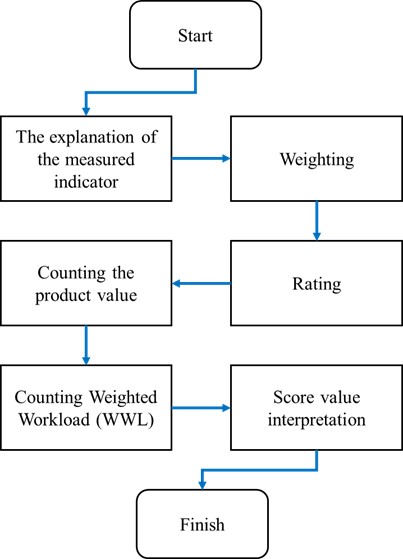The Mental Workload Analysis on Female Educators During Covid-19 Pandemic Using Nasa-TLX Method
DOI:
https://doi.org/10.12928/si.v21i1.87Keywords:
Covid-19, Female Worker, Mental Workload, NASA-TLX, PandemicAbstract
The fate of women workers during the pandemic is quite worrying. The role of women's triple burden in these times is getting heavier. Mental workload is a multidimensional construct that demands attention, performance, and skills of workers according to their work environment. This study aims to find out the mental burden felt by female workers during the pandemic. The subjects of this study were female educators at the University of Balikpapan. Five subjects feel a Very high mental burden on work activities during a pandemic, namely subjects 06, 14, 19, 23, and 25. There are 18 subjects who feel a high mental burden including subjects 3, 4, 5, 7, 8, 10, 12, 13, 16, 17, 18, 20, 21, 26, 28, 29, 30, and 31. Then, 3 subjects felt a moderate mental load, and 2 subjects felt a low mental load. If average, then the mental workload of female educators at the University of Balikpapan is 56.623 categorized as high. This study also seeks to investigate the correlation between the perceived workload of the subjects and several factors including age, marital status, education level, address, family size, income, COVID-19 survivor status, and family members who are COVID-19 survivors. The result showed that the number of family members is the only significant factor that influences the mental workload.
References
Giyanti, I., & Fachrizal, I. (2021). Beban Kerja Mental Guru SD di Masa Pandemi Covid-19 Menggunakan Metode NASA-TLX. 1st E-Proceeding SENRIABDI 2021, 1(1), 123–132.
Hart, S. G., & Staveland, L. . (1988). Development of NASA-TLX (Task Load Index): Result of empirical and theoretical research. Human Mental Worload, 239–250.
Kahneman, D. (2020). Thinking, fast and Slow. Gramedia pustaka utama.
Nofri, T., Prastawa, H., & Susanto, N. (2017). Pengukuran Beban Mental di Kalangan Mahasiswa Menggunakan Metode NASA-TLX (Studi Kasus: Mahasiswa Departemen Teknik Industri Undip). Industrial Engineering Online Journal, 6(2), 1–10.
Radhitya, T. V., Nurwati, N., & Irfan, M. (2020). Dampak Pandemi COVID-19 Terhadap Kekerasan dalam Rumah Tangga. Jurnal Kolaborasi Resolusi Konflik, 2(2), 111. https://doi.org/10.24198/jkrk.v2i2.29119
Sari, E. K., & Fikri Zufar, B. N. (2021). Perempuan Pencari Nafkah Selama Pandemi Covid-19. Al-Mada: Jurnal Agama, Sosial, Dan Budaya, 4(1), 13–29. https://doi.org/10.31538/almada.v4i1.1106
Septiyani, E. N., Rahmawati, S., & Sayekti, A. (2021). Analisis Beban Kerja dan Kebutuhan Tenaga Kerja Optimal Pada Divis Finance & Treasury PT. Sawit Permai Lestari. Jurnal Ilmiah Teknik Industri, 9(2), 105–116.
Tarwaka. (2010). Ergonomi industri: Dasar-dasar pengetahuan ergonomi dan aplikasi di tempat kerja. Harapan Press Solo.
Tversky, A., & Kahneman, D. (1986). This work has appeared. In The Journal of Business, 59(4), 251–278.
Yasmin, Z. A., & Ariyanti, S. (2019). Analisis Beban Kerja Pada Maintenance Bd-Check Dengan Metode Full Time Equivalent. Jurnal Ilmiah Teknik Industri, 6(1), 55–62. https://doi.org/10.24912/jitiuntar.v6i1.3024
Young, M. S., Brookhuis, K. A., Wickens, C. D., & Hancock, P. A. (2015). State of science: mental workload in ergonomics. In Ergonomics (Vol. 58, Issue 1, pp. 1–17). Taylor & Francis. https://doi.org/10.1080/00140139.2014.956151
Yuamita, F., & Sary, R. A. (2017). Usulan Perancangan Alat Bantu Untuk Meminimalisir Kelelahan Fisik dan Mental Pekerja. Jurnal Ilmiah Teknik Industri, 15(2), 127. https://doi.org/10.23917/jiti.v15i2.2424

Downloads
Published
How to Cite
Issue
Section
License
Copyright (c) 2023 Dimaz Harits, Marulan Andivas, Agus Hindarto Wibowo, Eaden Ahmed Thoriq, Ihwan Ghazali

This work is licensed under a Creative Commons Attribution-ShareAlike 4.0 International License.









.png)




